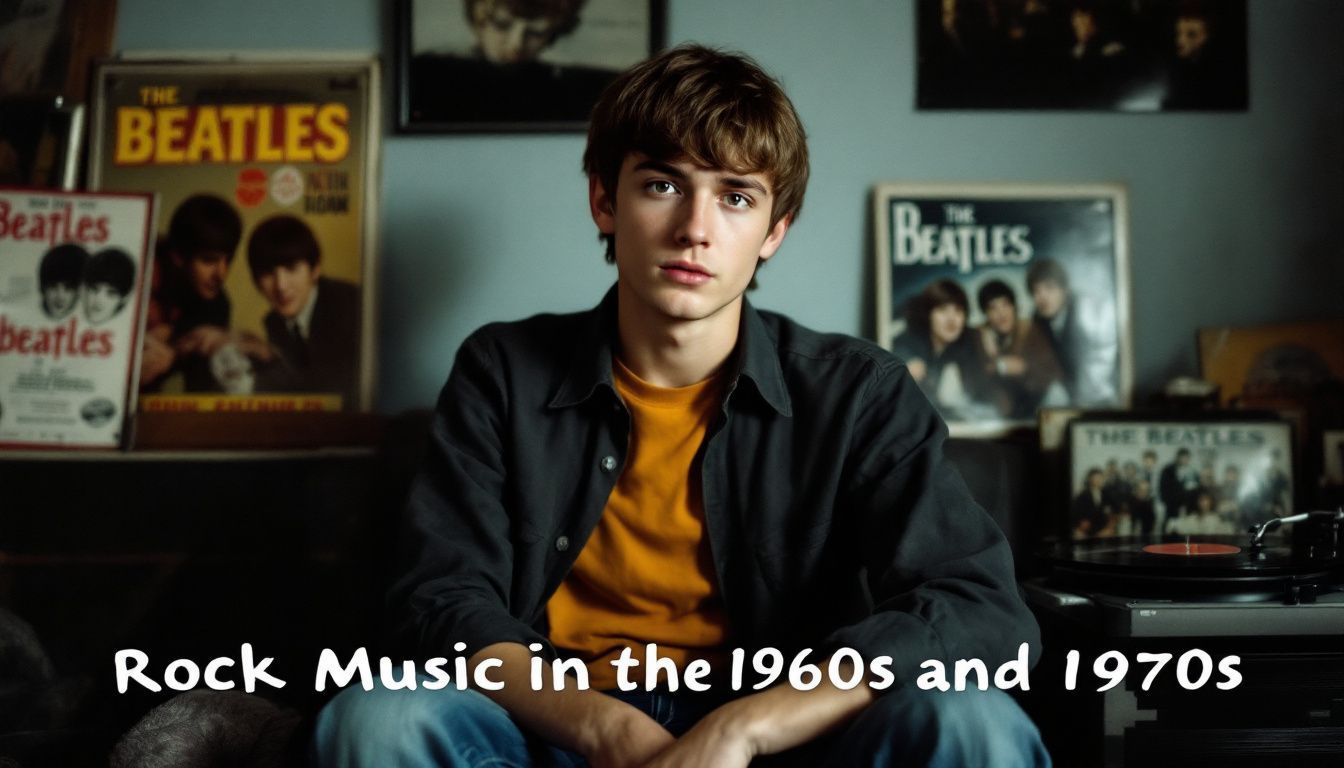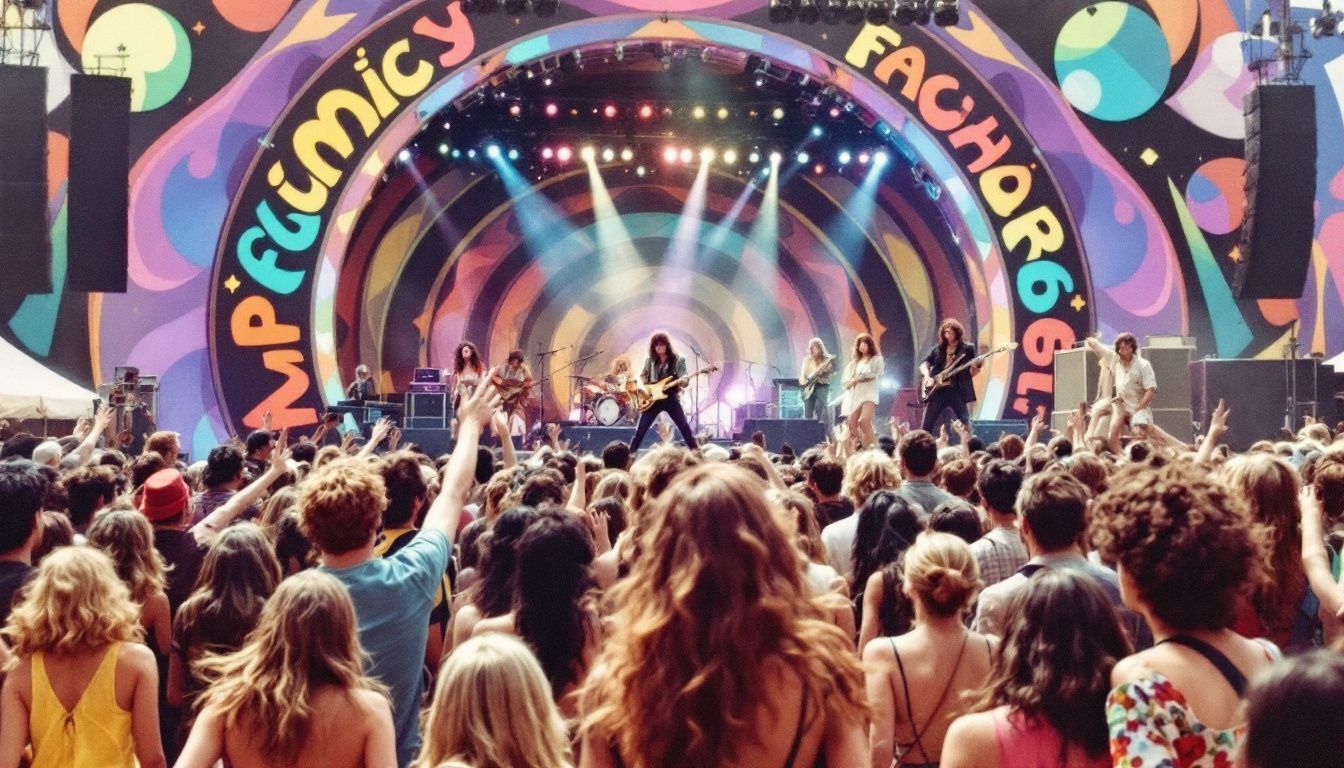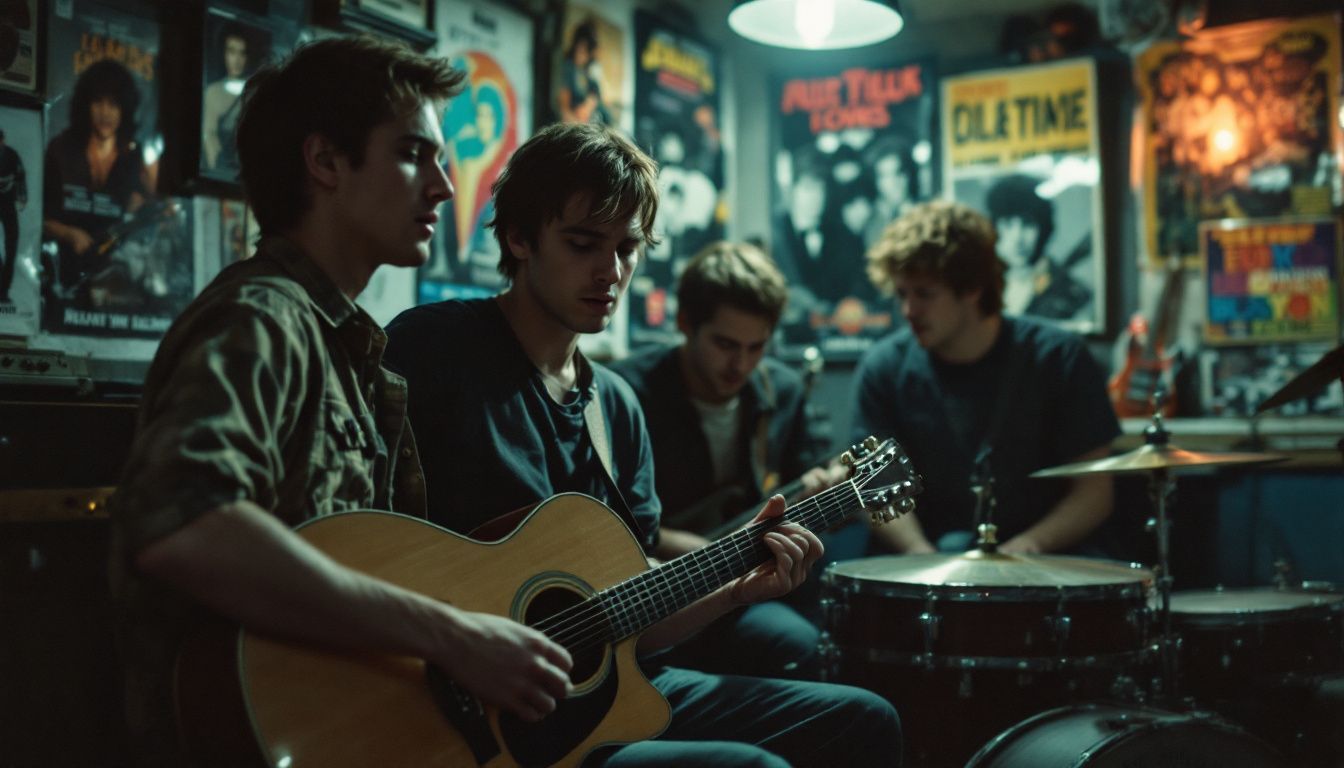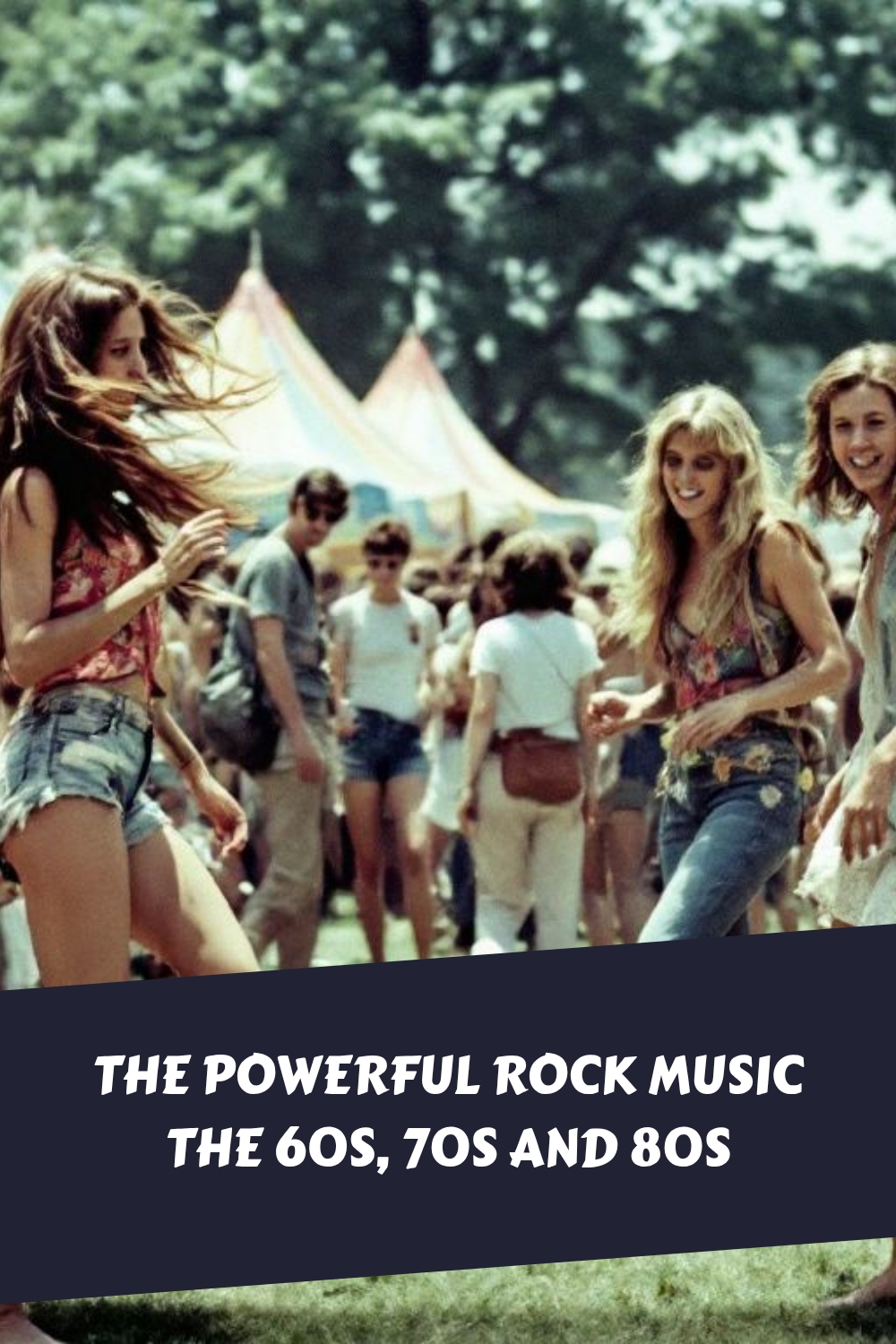Trying to understand rock music from the 1960s and 1970s can seem tough. With so many bands, songs, and styles, where do you start? If you’re feeling lost in the sea of classic rock, rhythm and blues, and Motown’s hits, you’re not alone.
The good news is that this post will guide you through the maze of guitar riffs, soulful vocals, and groundbreaking albums that defined two vibrant decades.
Did you know that during the 1960s and 1970s rock music truly came into its own? It was a time when musicians blended blues traditions with modern sounds to create something entirely new.
This period gave us legends like The Beatles from the British Invasion and The Supremes from Motown’s golden lineup – artists who still influence music today. Our blog will help make sense of these changes—showing how different sounds collided to shape what we now know as rock ‘n’ roll.
Get ready for a journey back in time.
Key Takeaways
- In the 1960s and 1970s, rock music mixed with blues to create new sounds. Bands like The Beatles and The Rolling Stones led this change. They brought British rock to America, changing music here.
- Psychedelic rock used dreamy lyrics and effects for a new style. Pink Floyd and The Grateful Dead were big names in this era. They made concerts feel like other worlds with their unique sounds.
- Hard rock and heavy metal grew from basic rock n’ roll. Led Zeppelin and Black Sabbath had loud guitars and strong vocals that made these genres popular.
- Motown added soul to rock music. Marvin Gaye and Aretha Franklin mixed deep emotions into their songs, touching listeners’ hearts.
- Music festivals like Woodstock showed how live shows could bring people together for peace through music. These events celebrated different styles within rock, making it part of popular culture.
SHOP NOW ZAZZLE - CLICK BELOW
Rock and Roll Roots
Rock music originated in the United States in the late 1940s and early 1950s as “rock and roll,” blending African-American rhythm and blues, gospel, and country music. Pioneers like Chuck Berry, Little Richard, Elvis Presley, and Fats Domino laid the foundation for the genre, with early hits such as “Rocket 88,” “Rock Around the Clock,” and “Maybellene” defining the sound and attitude of rock and roll.
1960s Rock Bands and the British Invasion
The 1960s marked a revolution in rock music. The British Invasion, beginning in 1963–1964, saw bands like The Beatles, The Rolling Stones, The Who, The Kinks, and The Animals storm the American charts and reshape popular rock music worldwide. These bands drew from American blues and R&B but added their own energy and style.
Key American bands of the era included The Doors, Jefferson Airplane, The Beach Boys, and Janis Joplin, who helped define the West Coast sound and the explosion of psychedelic rock. The 1960s also saw the rise of protest music and social commentary in rock, with artists like Bob Dylan leading the charge.
Psychedelic Rock and Counterculture
Psychedelic rock emerged in the mid-to-late 1960s, fueled by the hippie movement and countercultural ideals. Bands like The Grateful Dead, Jefferson Airplane, and The 13th Floor Elevators pioneered the genre, which was characterized by experimental sounds, surreal lyrics, and a focus on altered states of consciousness. The Beatles’ Sgt. Pepper’s Lonely Hearts Club Band and The Byrds’ “Eight Miles High” were pivotal in bringing psychedelic sounds to the mainstream.
Woodstock Era and the Festival Movement
The late 1960s culminated in the Woodstock Music and Art Fair (1969), a defining event for the counterculture and rock music. Featuring performances by Jimi Hendrix, The Who, Jefferson Airplane, and others, Woodstock symbolized peace, love, and the power of music to unite people129.
1970s Rock Legends and Classic Rock Evolution
The 1970s saw rock diversify into numerous subgenres, including hard rock, heavy metal, glam rock, and progressive rock113. Legendary artists and bands like Led Zeppelin, Pink Floyd, Black Sabbath, Queen, Bruce Springsteen, Elton John, and Deep Purple dominated the decade1487. Iconic albums such as Led Zeppelin IV, Dark Side of the Moon, and Born to Run defined the era.
Progressive rock bands like Yes, Genesis, and Rush pushed musical boundaries, incorporating classical and jazz elements into rock1513. Heavy metal, pioneered by Black Sabbath, introduced a darker, heavier sound that would influence generations to come813.
Iconic Guitar Riffs and Rock Band Pioneers
Rock music is renowned for its memorable guitar riffs. Classic riffs from songs like “Smoke on the Water” (Deep Purple), “Purple Haze” (Jimi Hendrix), “Walk This Way” (Aerosmith), and “Sweet Child O’ Mine” (Guns N’ Roses) have become cultural touchstones16. Pioneering bands and artists—from early rockabilly stars to progressive rock innovators—shaped the genre’s evolution and continue to inspire musicians today41513.
Classic Rock and the Music Revolution
Classic rock, broadly defined as rock from the 1960s through the 1980s, remains a staple of music culture137. The genre’s evolution reflects broader social changes, from the protest movements of the 1960s to the stadium rock spectacles of the 1970s and the punk and new wave reactions of the late 1970s and 1980s110. The legacy of classic rock is evident in the enduring popularity of bands like The Beatles, Led Zeppelin, Queen, and Pink Floyd.
Rock Music Timeline and Legendary Artists
| Era | Key Events/Bands/Artists | Notable Characteristics |
|---|---|---|
| 1950s | Elvis, Chuck Berry, Little Richard | Birth of rock and roll |
| 1960s | Beatles, Stones, Doors, Dylan | British Invasion, psychedelic rock |
| Late 1960s | Hendrix, Woodstock, Jefferson Airplane | Counterculture, festival movement |
| 1970s | Zeppelin, Floyd, Sabbath, Queen | Album-oriented rock, progressive rock |
| 1980s | AC/DC, Metallica, Guns N’ Roses | Hard rock, heavy metal, new wave |
Summary
Rock music’s history is a story of constant evolution, shaped by legendary artists, groundbreaking bands, and revolutionary moments. From its roots in rhythm and blues to the British Invasion, psychedelic rock, the Woodstock era, and the rise of classic and progressive rock, the genre has continually reinvented itself while remaining a powerful force in global culture
The Role of the British Invasion in shaping 70s rock legends
The British Invasion of the 1960s played a foundational role in shaping the rock legends of the 1970s by fundamentally altering the landscape of rock music and establishing new artistic and cultural standards that subsequent generations would build upon.
Redefined the Rock Band Model
The British Invasion popularized the concept of the self-contained rock group—bands that wrote their own music, played their own instruments, and cultivated a distinct group identity. This model became the standard for all rock bands that followed, including the legendary acts of the 1970s.
Blues and R&B Roots
Bands like The Rolling Stones and The Yardbirds drew heavily from American blues and rhythm and blues, reintroducing these styles to American audiences and inspiring future rockers to incorporate blues-based riffs and structures into their music. This influence is evident in the sound of Led Zeppelin, Black Sabbath, and other 1970s rock icons.
Innovation and Experimentation
The Beatles and other British Invasion bands pushed the boundaries of studio production, songwriting, and musical arrangements. Their willingness to experiment with new sounds and genres—such as psychedelic rock, progressive rock, and hard rock—paved the way for the more complex and ambitious music of the 1970s.
Cultural and Attitudinal Influence
The British Invasion bands introduced a new attitude of rebelliousness, individualism, and artistic integrity. This spirit of defiance and self-expression became central to the identity of rock music and was embraced and amplified by 1970s legends like Led Zeppelin, Pink Floyd, and Queen.
Legacy of Musical Pioneering
The British Invasion’s impact is seen in the development of acid rock, heavy metal, and progressive rock—all genres that flourished in the 1970s. Bands that emerged from this era, such as Deep Purple and Black Sabbath, were directly influenced by the innovations and attitudes of their 1960s British predecessors
Summary Table
| British Invasion Influence | Impact on 1970s Rock Legends |
|---|---|
| Self-contained band model | Standard for 1970s rock bands |
| Blues/R&B revival | Foundation for hard rock and heavy metal |
| Studio innovation | Inspired progressive and experimental rock |
| Rebellious attitude | Central to 1970s rock ethos |
| Genre pioneering | Led to acid rock, prog rock, heavy metal |
In summary, the British Invasion not only revitalized rock music in the 1960s but also laid the groundwork for the creative explosion and legendary status of 1970s rock acts, who built upon the musical, cultural, and attitudinal innovations of their British predecessors
Lorem ipsum dolor sit amet, consectetur adipiscing elit. Ut elit tellus, luctus nec ullamcorper mattis, pulvinar dapibus leo.
The British Invasion

The British Invasion reshaped American rock music. Bands like The Beatles and The Rolling Stones brought new sounds across the ocean, changing what we listened to forever.
Influence of British bands on American rock music British bands changed American rock in big ways. Groups like The Beatles and The Rolling Stones brought new sounds to the U.S. They mixed rock-and-roll with British beat and rhythm and blues.
British bands changed American rock in big ways. Groups like The Beatles and The Rolling Stones brought new sounds to the U.S. They mixed rock-and-roll with British beat and rhythm and blues.
This made something fresh and exciting.
The Beatles showed up on TV in America and blew everyone’s mind. People loved their music. Bands from Britain started to play a big role in American music charts.
American groups began to copy the British style. They added more guitar sounds and tried new things with their music. Music from both sides of the Atlantic Ocean started to blend together.
This created a rich time for rock music.
Fans went wild for this new mix of tunes. Concerts got bigger, and albums sold by the millions. Rock festivals became huge events, thanks to this influence too.
Key bands: The Beatles, The Rolling Stones
The Beatles and The Rolling Stones changed rock music forever. Their sounds still influence musicians today.
- The Beatles
- This band formed in Liverpool in 1960. They quickly rose to fame during the British Invasion. Their catchy tunes won hearts across the globe. Hits like “Hey Jude” and “Let It Be” are classics today.
- They pushed the boundaries of music, focusing on albums rather than singles. Their work helped shape rock as an art form.
- Each member had unique talents that shone through their music. Paul McCartney’s melodies blended well with John Lennon’s lyrics. Together, they created timeless songs.
- The Rolling Stones
- Founded in London in 1962, this band became a symbol of rock excess. Known for their wild performances, they captured the spirit of the 60s and 70s.
- Hits like “Paint It Black” and “(I Can’t Get No) Satisfaction” defined their sound. Mick Jagger’s powerful voice paired perfectly with Keith Richards’ rhythm guitar skills.
- They faced challenges too, losing members like Brian Jones at a young age. Despite this, they continued to grow and thrive as a band.
- Cultural Impact
- Both bands sparked a passion for rock music among fans worldwide.
- The Beatles inspired many girl groups and artists, including The Ronettes and Martha and the Vandellas.
- The Rolling Stones influenced hard rock genres with their bold style, paving the way for bands like Led Zeppelin.
These two bands shaped rock music and impacted culture itself. Their legacy lives on through their songs and influence on future artists.
The Psychedelic Era

The Psychedelic Era brought a burst of color and sound to rock music. Bands like Pink Floyd and The Grateful Dead used new styles, with dreamy lyrics and unique sounds, to create an experience that felt otherworldly…
Their music pushed boundaries and invited fans to explore deep feelings through art.
https://www.youtube.com/watch?v=tg–8NDbD90
Hallmarks of psychedelic rock
Psychedelic rock emerged in the mid-1960s. It pushed musical boundaries. Bands like Pink Floyd and The Grateful Dead led this wave. They combined rock with surreal sounds and heavy use of effects.
This style often featured long instrumental solos, strange lyrics, and innovative recording techniques.
Fans enjoyed colorful artwork and wild stage shows too. These performances aimed to create an experience that matched the music’s vibe. Themes of love, peace, and exploration floated in the air as artists experimented with their art forms.
The genre reflected a culture hungry for change during a transformative time in history. Rock music began to embrace its blues roots while drawing from jazz influences and Motown beats as well…
This unique blend made psychedelic rock distinctive and memorable.
Notable bands
Pink Floyd, The Grateful Dead
Pink Floyd and The Grateful Dead were two key bands in the psychedelic era. Their music shaped rock in the 1960s and 1970s, exploring new sounds and ideas.
- Pink Floyd
- This band rose to fame in the mid-1960s. They mixed rock with deep lyrics and innovative sounds.
- Albums like “The Dark Side of the Moon” became timeless classics. This album spent over 900 weeks on the charts.
- Their music often explored themes of madness and alienation. Songs like “Comfortably Numb” showcase their unique style.
- The Grateful Dead
- Known for their experimental style, they formed in 1965. Their blend of rock, jazz, bluegrass, and folk was revolutionary.
- The band was famous for its live performances. They encouraged improvisation during shows, making each concert unique.
- Hits like “Casey Jones” and “Sugar Magnolia” remain popular today. Their loyal fans formed a vibrant community called “Deadheads.”
These bands significantly influenced rock and highlighted the era’s creativity and spirit. Next up is how hard rock evolved into heavy metal during these decades…
Development of Hard Rock and Heavy Metal

Hard rock and heavy metal changed music forever. Bands like Led Zeppelin and Black Sabbath took rock n’ roll to new heights with louder sounds and powerful riffs. Their music was raw, intense, and full of energy—capturing the spirit of a generation.
Guitarists pushed limits with flashy solos that amazed fans everywhere….
Evolution from rock n’ roll to harder sounds
Rock and roll laid the groundwork for harder sounds in music. In the mid-1960s, artists began to explore deeper blues roots. This shift led to heavier styles like hard rock and heavy metal.
Bands like Led Zeppelin and Black Sabbath were pioneers of these new sounds. Their music was louder, with powerful guitar riffs and strong vocals.
The 1970s embraced excess, as bands became larger than life. Rock musicians prioritized albums over singles during this time. The focus shifted from catchy tunes to full musical experiences.
Rock was evolving rapidly, shaping a new era that still influences artists today.
Pioneers: Led Zeppelin, Black Sabbath
Led Zeppelin and Black Sabbath reshaped rock music in powerful ways. Their unique sounds pushed the genre into new territories.
-
Led Zeppelin’s Formation
Led Zeppelin formed in 1968. The band included Robert Plant, Jimmy Page, John Paul Jones, and John Bonham. They mixed blues with hard rock. This blend created a whole new style.
-
Iconic Albums
Their first album, “Led Zeppelin,” hit stores in 1969. Songs like “Dazed and Confused” showcased their heavy sound. In 1971, “Led Zeppelin IV” featured “Stairway to Heaven.” This song became a classic rock anthem.
-
Innovative Sound
Led Zeppelin was known for its layered music. They used electric guitars and powerful vocals to create depth. Jimmy Page’s guitar work, combined with Plant’s voice, set them apart.
-
Black Sabbath’s Impact
Black Sabbath formed in 1968 as well. The group included Ozzy Osbourne, Tony Iommi, Geezer Butler, and Bill Ward. They are often credited with inventing heavy metal music.
-
Dark Themes
Black Sabbath’s songs explored darker themes compared to other bands at the time. Their self-titled album came out in 1970 and included tracks like “N.I.B.” Fans were drawn in by their unique sound and eerie lyrics.
-
Pioneering Techniques
Tony Iommi’s heavy guitar riffs defined their style. His use of power chords influenced many future bands in the heavy metal scene.
-
Legacy of Both Bands
Both Led Zeppelin and Black Sabbath left lasting legacies on rock music. Bands today still cite them as inspirations for their own styles.
These pioneers changed how people viewed rock music forever!
Impact of Motown and Rhythm & Blues

Motown and Rhythm & Blues changed rock music forever. Artists like Marvin Gaye and Aretha Franklin brought soul into the mix, adding depth to the sound.
Contribution to rock music’s diversity
Rock music in the 1960s and 1970s became a melting pot of styles. The Motown label played a huge role in this change. Artists like Marvin Gaye, Aretha Franklin, and Smokey Robinson infused rock with their soulful sounds.
Their music added emotional depth to rock songs, making them more relatable.
Rhythm & blues also impacted rock’s diversity. Soul singers brought energy that changed how people viewed rock music. The Beach Boys, led by Brian Wilson, blended surfing sounds with rich harmonies.
This mix created fun melodies that captured listeners’ hearts.
The British Invasion further broadened this musical landscape. Bands like The Beatles and The Rolling Stones introduced new ideas and styles from England. They combined rock n’ roll’s roots with fresh influences from blues to pop rhythms—showing that rock could be much more than just one sound or style.
Rock was evolving into something bigger…something vibrant!
Influential artists:
Marvin Gaye, Aretha Franklin
Marvin Gaye and Aretha Franklin were key artists in the 1960s and 1970s. Their music shaped rock and brought new diversity to the genre.
- Marvin Gaye
- Known as the “Prince of Motown,” Marvin Gaye blended soul with rock music.
- His song “What’s Going On” became a huge hit in 1971. It addressed social issues like war and love, touching many hearts.
- Gaye’s smooth voice and deep lyrics set him apart from other artists at the time. He influenced many musicians who followed.
- Aretha Franklin
- Often called the “Queen of Soul,” Aretha Franklin made her mark with powerful vocals.
- Her version of “Respect,” released in 1967, became an anthem for both civil rights and feminism.
- Franklin’s style combined gospel, R&B, and rock elements, making her music timeless. She inspired countless singers with her bold sound.
These artists played major roles in rock music’s evolution during these vibrant decades. Their impact is still felt today, paving the way for future stars…
Rock Music Festivals as Cultural Phenomena

Rock music festivals changed everything. Woodstock in 1969 brought people together for peace and love through music. These events became a stage for new voices, like Janis Joplin and Jimmy Hendrix.
They showed how powerful live performances could be, making rock a huge part of culture.
Woodstock and the cultural impact of music festivals
Woodstock era music is considered a pivotal moment in rock history for several key reasons that go beyond the festival itself, shaping the trajectory of rock and broader popular music.
Cultural and Social Significance
Symbol of the Counterculture Movement
Woodstock, held in August 1969, became the defining event of the hippie era, embodying ideals of peace, love, and unity. It brought together hundreds of thousands of young people from diverse backgrounds, showcasing the power of music to unite and inspire a generation during a time of social and political upheaval, including the Vietnam War and civil rights struggles.
Amplification of Social and Political Messages
The festival amplified the role of music as a medium for social commentary. Artists used their performances to address issues such as war, civil rights, and environmentalism, setting a precedent for rock as a voice for change in the 1970s and beyond.
Musical Innovation and Influence Platform for Iconic Performances
Legendary acts like Jimi Hendrix, The Who, Janis Joplin, Santana, and Crosby, Stills, Nash & Young delivered performances that became cultural touchstones. Hendrix’s rendition of “The Star-Spangled Banner,” for example, is still widely regarded as one of the most powerful moments in rock history.
Musical Experimentation and Genre Blending
Woodstock featured a diverse lineup spanning rock, folk, blues, and soul, encouraging artists to experiment and blend genres. This spirit of innovation influenced the rise of progressive rock and fusion genres in the 1970s.
Extended Jam Sessions and Live Music Culture
The festival popularized extended jam sessions and improvisational performances, exemplified by bands like The Grateful Dead and Jefferson Airplane. This approach redefined live rock music and set new standards for concert experience
Woodstock was more than just a music festival. It became a symbol of peace and love in the late 1960s. Held in 1969, it featured iconic bands like The Grateful Dead and Jimi Hendrix.
These performers brought rock music to millions who gathered on that farm in New York. The event showed how powerful live performances could be.
Music festivals like Woodstock changed culture forever. They united people from different backgrounds, sparking conversations about social issues. Fans supported artists who sang about freedom and equality.
Festivals turned into spaces for expression and connection, influencing future generations of musicians—like Eric Clapton and Otis Redding—to create songs that resonated deeply with audiences.
The legacy of Woodstock lives on today through modern music festivals. The vibe of community still echoes as fans come together to celebrate their favorite bands. Nowadays, events attract thousands every year, reminding us of the spirit born during those memorable days in 1969.
The role of live performances in popularizing rock music
Live performances helped rock music become a big deal. Events like Woodstock brought thousands of fans together. These festivals were not just concerts; they were cultural movements.
They showcased iconic bands like The Beatles and The Rolling Stones, who defined the sound of the 1960s.
In the mid-1960s, musicians shifted focus to albums instead of singles. This change meant live shows became crucial for promoting their music. Bands used these performances to connect with fans and build their reputations.
Acts like Led Zeppelin and Black Sabbath created memorable experiences that drove people to buy records.
Rock festivals celebrated diversity too, blending different music styles. Motown artists showed how rhythm & blues influenced rock’s growth. Legends like Marvin Gaye and Aretha Franklin stood alongside rock icons, enriching the scene further.
Each show fostered a shared love for this evolving genre while helping bands reach new heights in popularity.
Legacy and Industry Impact
Rise of Festival Culture
Woodstock’s success demonstrated the commercial and cultural potential of large-scale music festivals, inspiring events like Glastonbury, Isle of Wight, and others in the 1970s and beyond.
Documentation and Immortality
The festival was immortalized in a landmark documentary and soundtrack album, ensuring its legacy and influence would endure for future generations.
Enduring Influence
Woodstock’s music and ethos continue to be celebrated and revisited, reminding audiences of the power of live music to transcend time and inspire new generations.
In summary, Woodstock era music is pivotal because it symbolized the counterculture movement, amplified rock’s role as a voice for social change, showcased legendary performances and musical experimentation, and established the template for modern music festivals and live rock culture
Conclusion: Legacy of 60s, 70s and 80s Rock Music

The 1960s and 1970s transformed rock music forever. Key bands like The Beatles and The Rolling Stones shaped its sound. Artists explored deep roots in blues, blending styles to create something new.
They began focusing on albums over singles, which expanded their creativity. Music festivals like Woodstock united fans and showcased diverse talent. Rock’s impact still resonates today, influencing countless artists across genres.
Celebrate this powerful legacy—what will you explore next in rock?
FAQs
1. Who were some key figures in the rock music scene during the 1960s and 1970s?
During the 1960s and 1970s, many influential artists shaped the rock music scene. Icons like Elvis Presley and Sam Cooke brought a unique blend of rhythm section beats to their music, while Carl Perkins was known for his skiffle group style. Other pivotal figures include Mary Wilson from The Marvelettes and Berry Gordy, who worked with Holland-Dozier-Holland.
2. What role did beat groups play in shaping rock music during this era?
Beat groups had a significant influence on rock music in the ’60s and ’70s. They incorporated elements of doo-wop into their sound, creating an innovative fusion that resonated with audiences worldwide.
3. How has Ray Charles influenced Rock Music during these decades?
Ray Charles’ unique blend of gospel-infused rhythms had a profound impact on rock music during this period. His soulful melodies added depth to traditional beat group sounds, paving the way for future generations of musicians.
4. How did rhythm sections contribute to evolving Rock Music’s sound in these years?
Rhythm sections played an integral part in defining rock’s sonic landscape during this time frame by providing steady beats that supported melodic lines from lead instruments or vocals—creating more complex musical textures.


 Cart is empty
Cart is empty 







